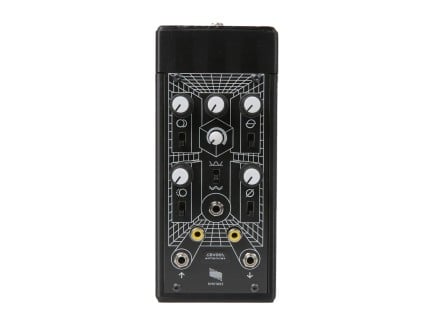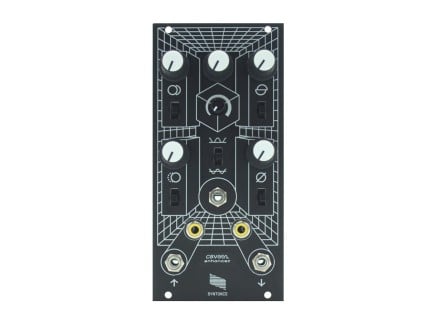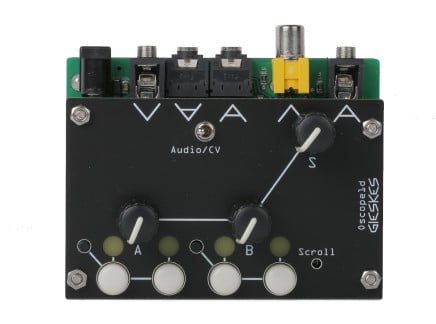We talk a lot about synthesis here at Perfect Circuit, but most of the time it's in the context of audio. But many of us are equally passionate, if not more so, about video synthesis—that is, generating waveforms to create visual imagery rather than sound. Though it often feels a bit more mysterious and abstract compared to its aural counterpart, video synthesis is gradually becoming a more accessible outlet for creative expression. This is in no small part thanks to not only the proliferation of the Eurorack modular format, but also fun, standalone video instruments being produced by LZX Industries, Critter & Guitari, and this article's featured brand: Syntonie.
As one of the emerging makers of video synthesis tools, Syntonie have been producing a growing line of Eurorack modules while proudly continuing to draw from the rich legacy of DIY practices at the origins of analog video synthesis. Our video editor Erin frequently makes use of Syntonie's devices in her work, especially the CBV001 Circuit Bent Video Enhancer. We thought it would be fun to turn the cameras around and allow Erin to share her expertise in the pseudo-behind-the-scenes video linked above, while using this article as a space to shine a spotlight on the CBV001, and offer some general tips on dipping your toes into video synthesis.
Enhance & Glitch: Syntonie's CBV001
So, what is the Circuit Bent Video Enhancer? It's not a complete video synthesizer by itself, but a more fitting comparison would be to think of it like an effect pedal—it doesn't generate video, but rather it processes and affects existing video signals in different ways. In some ways, this is even better than the CBV001 being a complete synth, because that means you can send any imagery into it that you like.
At its core, the CBV001 contains an enhancement circuit and four different glitch effects, all of which are dependent upon the enhancement settings. The enhance section mostly provides macro control over brightness and color saturation, but itself is capable of some glitching at extreme settings. But the dedicated glitch effects are where things get interesting, generating everything from blurring and filtering effects to sync distortion and edge feedback. Each section has wide ranging scope, but all share a similar interface that features a knob to set intensity, and a three-position switch for two variations of the effect or bypassing it entirely. As would be true with circuit bent equipment, all parameters are highly interactive with each other, and different, occasionally non-repeatable results will be had at different settings.
To interface with the outside world, the CBV001 provides two handy ways to get signals in and out of the device. The most universally useful option is the composite video jacks, which can process full RGB video signals with encoded sync. But if you're working within the context of an LZX video modular system, the adjacent 3.5mm jacks will also accept luma signals for monochromatic processing, and in a pinch the CBV001 could be used to encode or decode from one format to the other. There's also another 3.5mm input for voltage control over the Enhance circuit, accepting everything from DC voltages to video-rate signals.
Compared to most other items in the Syntonie catalog, the CBV001 is a bit special in that it is available as both a Eurorack module and in a standalone enclosure. While the former is nice for those already invested in Eurorack, the latter is a great option for anyone because it removes the physical and financial barriers that come along with the initial foray into modular synthesis. There's no need to worry about buying a case with a proper power supply—the standalone version is essentially plug and play!
Getting Up and Running with Video Synthesis
As shown in our video, Erin will usually capture a bunch of footage processed by the CBV001 that will end up edited, spliced, and layered together in Adobe Premiere to create special effects. But of course, that's just one of many ways that you could build up a video workflow. At minimum, you really just need a video source and a display to get the fun going! Bear in mind that with the CBV001 and a lot of other analog video gear, you'll likely be working with composite video signals—other formats like component, HDMI, and others will need adapters and converters to work properly.
There's a variety of video sources out there, with the most obvious choice being a good, old-fashioned camera for live input. But for pre-existing footage, our collective of video synthesis nerds here at Perfect Circuit have used everything from VCRs and old DVD players to retro game consoles and antique broadcasting equipment. These days, there's also plenty of video synthesis gear out there, both in standalone and modular formats, which would be great material for the CBV001 to chew on. This could be anything from the Critter & Guitari Video Scope to the Gieskes 3TrinsRGB+1c, or the encoded output from the Erogenous Tones Structure or the upcoming and highly-anticipated LZX Chromagnon.
Beyond hardware, if you rely upon video and editing software like Erin, then piping in footage from a computer video output card opens up worlds of opportunity. You could even just grab stock footage and free videos that can be found online—akin to sampling audio from the internet. Of course, creative video software applications like Touchdesigner, Max/MSP's Jitter family of objects, and a host of other platforms are great for being processed by analog video tools, much in the same way that running tracks from a DAW through outboard gear can liven things up in a meaningful way.
Of course, it's important to be able to see the result of using video tools like the CBV001, so some kind of display or monitor is a vital piece of the puzzle. If you're reading this article, there's a good chance that you already have a TV or computer monitor which could easily be used for video synthesis fun. I've even borrowed a projector in a pinch—just remember the important thing is to have the proper video connection formats! Even if you're not lucky enough to find a junk TV on the side of the road, there's more equipment available than ever before thanks to the rise of various streaming and gaming platforms, so finding some form of capture card that works with your existing TV or computer should be a fairly easy task.
Lights, Camera, Action!
By now, we hope it's clear that getting into video synthesis doesn't have to be a huge ordeal. Devices like the CBV001 prove that visual hardware doesn't necessarily have to be another big investment of time and brain power—you can just grab a camera and a TV, twist some knobs, and have fun! With so much of our time focused on the audio side of things, video synthesis can be a fun way for us to refresh ourselves by exploring something a bit different. With all that said, stay tuned for more about video synthesis from us in the future, in the form of both quick tips and deep dives.











